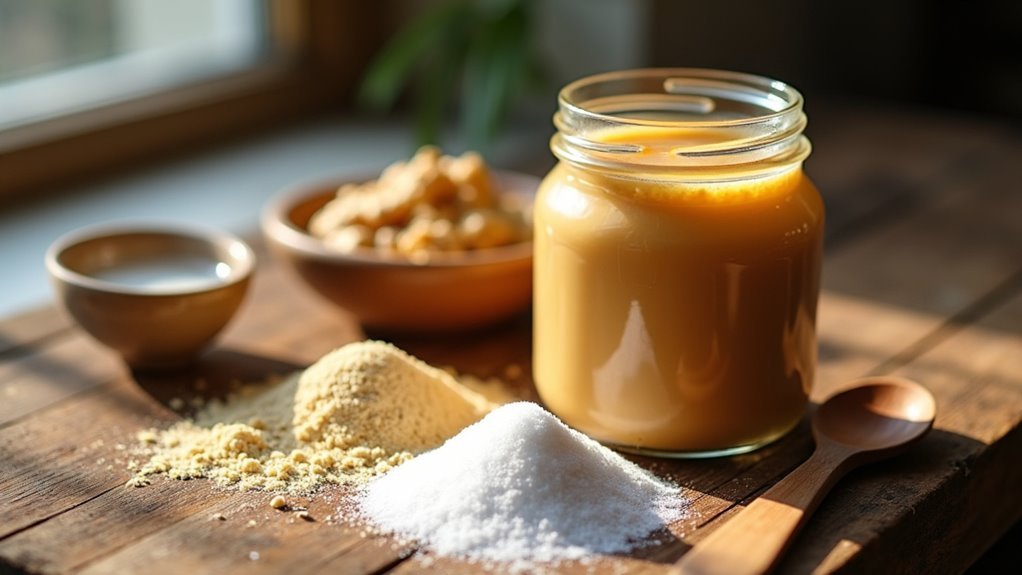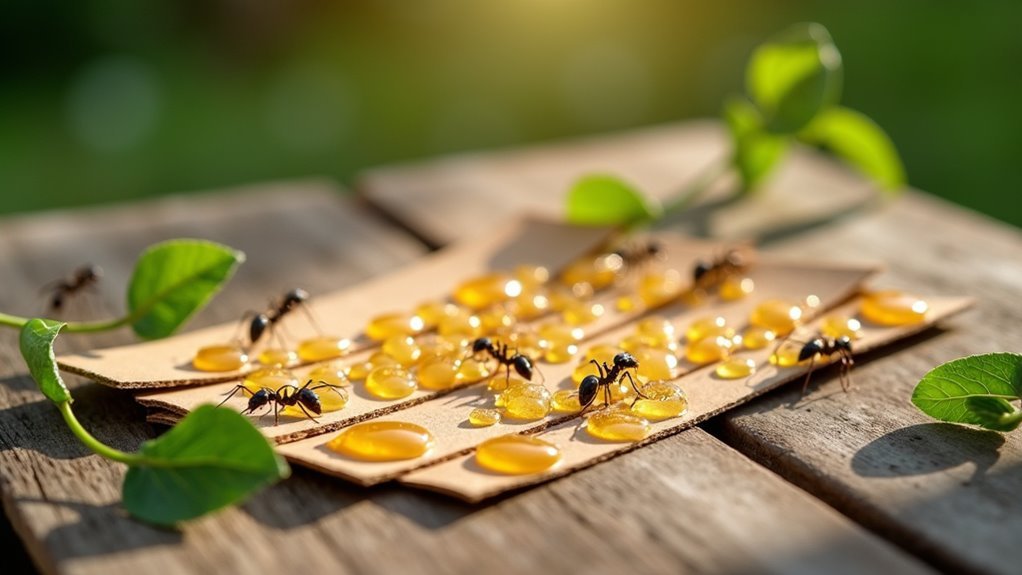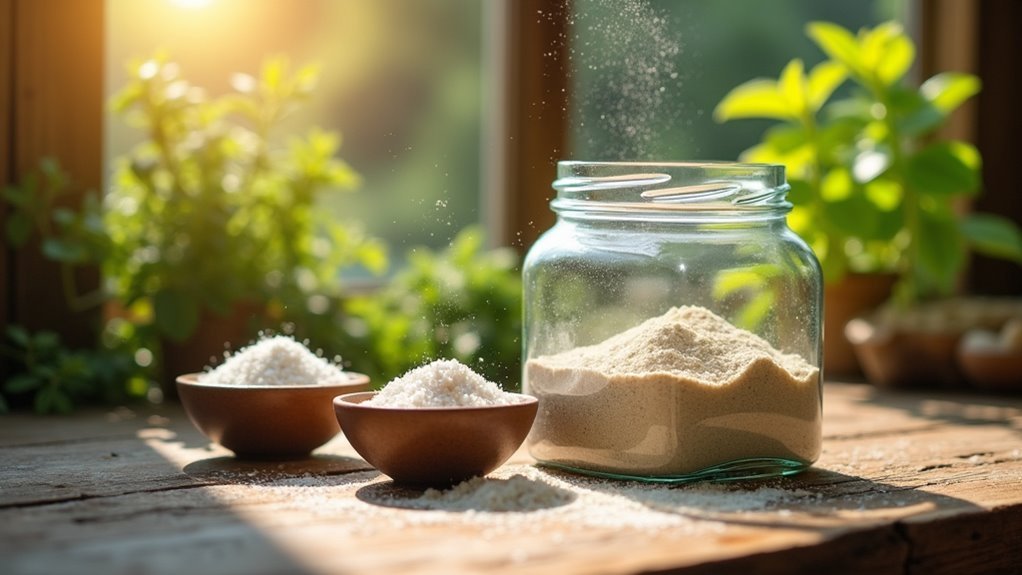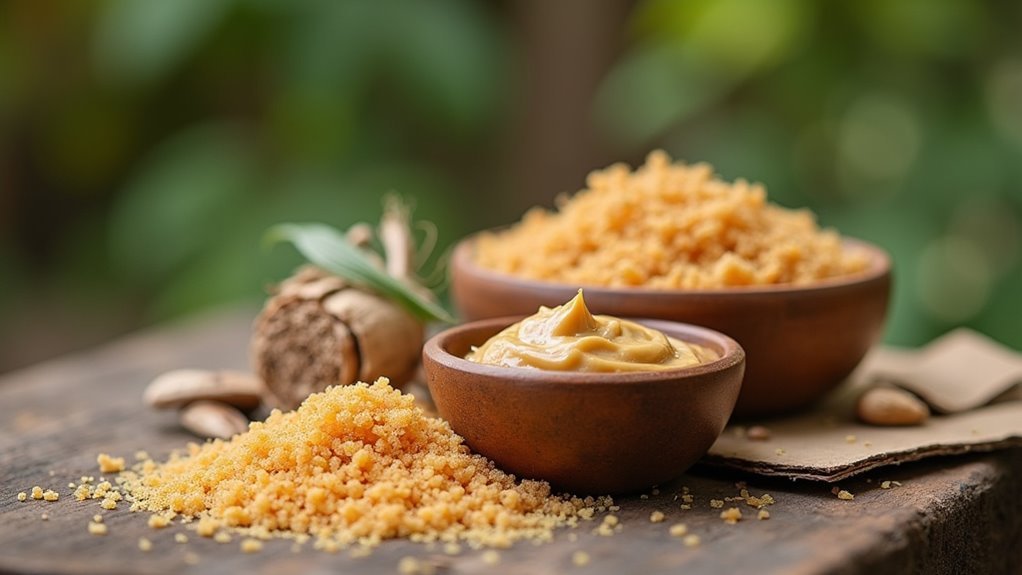You can make effective termite baits using common household items like boric acid mixed with sugar and water, then soaking cotton balls or cardboard pieces in the solution. Create cardboard traps by wetting old boxes and treating them with orange oil or cayenne pepper-vegetable oil mixtures. Diatomaceous earth combined with sugar also works well to attract and dehydrate termites. Place these baits near mud tubes and moisture-rich areas, checking weekly for activity to discover advanced placement strategies.
Essential Ingredients for Effective Termite Baits

When tackling a termite problem, you’ll need the right ingredients to create effective homemade termite bait that actually work.
Old cardboard serves as your primary base material since termites are naturally drawn to its cellulose content.
Cardboard’s cellulose fibers make it an irresistible attractant, turning this household waste into your most effective termite monitoring tool.
Orange oil containing d-limonene acts as a powerful toxic agent that you can spray directly or mix with cardboard.
Boric acid disrupts termites’ digestive systems and works excellently when dissolved in water for application.
Common table salt creates a dehydrating solution that kills termites at entry points.
Diatomaceous Earth damages their exoskeletons when sprinkled in infested areas.
These readily available ingredients help you control termites effectively while monitoring termite infestations without expensive commercial treatments.
Boric Acid and Sugar Mixture Recipe
Creating a boric acid and sugar mixture offers one of the most effective homemade termite baits you can make. This simple recipe combines one cup of water with one tablespoon each of boric acid and sugar, stirring until completely dissolved.
The sugar attracts termites while boric acid disrupts digestive systems, leading to elimination.
Here’s how to deploy your homemade bait:
- Soak cotton balls or cardboard pieces in the solution
- Place bait stations near suspected termite activity areas like mud tubes
- Check and replace regularly to maintain effectiveness
This cost-effective approach provides a safer alternative to commercial pesticides, making it ideal for homes with pets and children.
Monitor your bait stations consistently to eliminate termites effectively.
Cardboard Trap Bait With Natural Attractants

You can create an effective cardboard trap by breaking down old boxes, wetting them to soften the material, and treating them with natural attractants like orange oil or a cayenne pepper-vegetable oil mixture.
Position multiple traps around your home’s perimeter where you’ve noticed termite activity, as the cellulose in cardboard naturally draws these pests.
Check your traps regularly, and when you find infested cardboard, burn it immediately to eliminate the termites and prevent further spread.
Cardboard Preparation Methods
Three simple materials form the foundation of an effective cardboard termite trap: old cardboard boxes, water, and natural attractants.
Breaking down these boxes properly guarantees your cardboard traps will successfully lure termites and help with monitoring infestations.
Start by tearing cardboard into manageable sections, then thoroughly wet the material until it’s soft and pliable.
This moisture makes the homemade bait irresistible to termites seeking cellulose.
To maximize effectiveness against termite problems, enhance your preparation with:
- Orange oil mixture – Add several drops to wet cardboard for natural attraction
- Borax solution – Mix with water before applying to increase termite appeal
- Strategic saturation – Guarantee even moisture distribution throughout all pieces
Once termite activity appears in the infested material, dispose of it immediately by burning.
Natural Attractant Applications
While cardboard alone attracts termites effectively, adding natural attractants amplifies your trap’s success rate considerably.
You’ll want to enhance your cardboard traps by applying orange oil or neem oil to the moistened cardboard surface. These natural oils create a dual-action system where the cardboard serves as your primary homemade bait while the oils provide additional attraction properties.
Position these enhanced traps near suspected termite activity zones, particularly around mud tubes and areas showing wood damage signs. The combination works exceptionally well because termites are drawn to the cellulose while the natural oils increase the trap’s appeal.
Check your traps weekly for termite presence, and once you’ve captured termites, immediately burn or dispose of the infested cardboard to eliminate the colony members you’ve successfully trapped.
Trap Placement Strategy
Strategic placement of your enhanced cardboard traps determines whether you’ll successfully intercept termite colonies or waste time monitoring empty bait stations.
Your trap placement strategy should focus on infested areas where you’ve spotted visible signs of termite activity like mud tubes or frass piles.
For ideal results, position your natural attractants-enhanced cardboard traps:
- Near moisture sources like leaky pipes or damp basement areas
- Along foundation walls where termites typically establish entry points
- Close to wooden structures showing damage or hollow sounds
Check your cardboard traps weekly to monitor termite activity effectively.
Once you discover termites inside the bait, immediately dispose of the cardboard by burning it completely to eliminate captured pests and prevent reinfestation in your property.
Diatomaceous Earth Combination Formulas

Diatomaceous earth serves as the foundation for several potent homemade termite bait formulas that combine natural attraction with lethal effectiveness.
You can create an effective homemade bait by mixing diatomaceous earth with sugar, which attracts termites while the powder dehydrates their exoskeletons to kill termites on contact.
For targeted treatment, combine diatomaceous earth with small amounts of water to form a paste that you’ll apply directly to infested wood surfaces.
Another powerful formula involves blending diatomaceous earth with orange oil, leveraging the oil’s repellent properties while enhancing the powder’s killing power.
Apply diatomaceous earth regularly around foundations and wooden structures as a preventive measure against future termite activity infestations.
Oil-Based Termite Bait Solutions
You’ll find oil-based solutions particularly effective because they penetrate deep into wood and directly attack termites’ cellular structure.
The orange oil spray method harnesses d-limonene’s power to kill termites on contact, while neem oil disrupts their reproductive cycle when injected into infested areas.
These natural alternatives offer you a safer approach that won’t harm your family or pets while maintaining long-term protection against future infestations.
Orange Oil Spray Method
When you’re looking for a natural termite control solution, orange oil spray emerges as one of the most effective homemade options available. The d-limonene in orange oil kills termites on contact and helps create a barrier against future invasions.
This non-toxic to humans approach offers excellent termite control without harmful chemicals.
To prepare your spray:
- Mix pure orange oil with water in a spray bottle
- Apply directly to suspected termite-infested areas
- Reapply regularly, especially after rain or cleaning
While orange oil effectively deters and eliminates termites, severe infestations may require professional pest control assistance.
You’ll need consistent reapplication to maintain effectiveness, but this environmentally friendly method provides safe termite control around pets and family members without compromising your household’s health.
Neem Oil Application Technique
Another powerful natural termite control method involves neem oil, which contains azadirachtin—a compound that disrupts termite growth and reproductive systems.
To create this effective termite bait, mix 2 tablespoons of neem oil with 1 gallon of water and spray directly onto areas showing termite activity.
For enhanced results, inject neem oil into wooden structures using a syringe to target hidden termites within the wood itself. This injection method guarantees the compound reaches termites that surface spraying might miss.
Apply neem oil every few weeks to maintain its repellent effects and prevent future infestations.
Since neem oil is non-toxic to humans and pets, you can safely use this natural solution throughout your home without worrying about harsh chemical exposure.
Testing and Placement Strategies for Homemade Baits
Effective placement of your homemade termite baits requires strategic positioning in areas where these destructive insects are most likely to encounter them. Focus on entry points, mud tubes, and moisture-rich zones where termites naturally congregate. Cardboard soaked in water or orange oil works exceptionally well as these pests are drawn to cellulose materials.
Strategic bait placement near entry points, mud tubes, and moisture zones maximizes termite encounters for effective homemade control solutions.
Key placement strategies include:
- Multiple stations – Position baits around the perimeter of your home to maximize termite encounters
- High-activity zones – Target areas showing visible termite activity or damage
- Regular monitoring – Check stations weekly for termites or frass presence
You’ll need to monitor effectiveness consistently, replacing baits as needed. If your homemade baits aren’t reducing termite populations after several weeks, consider combining them with other control methods for enhanced results.
Frequently Asked Questions
What Is the Best Homemade Termite Killer?
You’ll find boric acid mixed with water works best as a homemade termite killer. Spray it directly on affected areas to disrupt their digestive systems and eliminate the entire colony effectively.
What Is a Simple Home Remedy for Termite?
You can place wet cardboard in infested areas to attract termites, then remove and burn it. Alternatively, sprinkle diatomaceous earth around affected areas to dehydrate termites naturally.
Will Vinegar and Dawn Kill Termites?
Yes, you’ll kill some termites on contact when you spray vinegar and Dawn directly on them. However, this mixture works better as prevention than complete elimination for serious infestations.
What Are the Ingredients in Termite Bait?
You’ll find termite bait contains cardboard for attraction, orange oil with d-limonene for killing, borax to disrupt nutrition, cayenne pepper mixed with oil, and diatomaceous earth to dehydrate termites effectively.
In Summary
You’ve now learned several proven homemade termite bait recipes using common household ingredients. Remember that consistency is key—you’ll need to monitor and refresh your baits regularly for best results. Don’t expect overnight success; termite elimination takes patience and persistence. If you’re dealing with a severe infestation, you should consider combining these DIY methods with professional treatment. Start with the boric acid mixture, as it’s typically the most effective option.





Leave a Reply